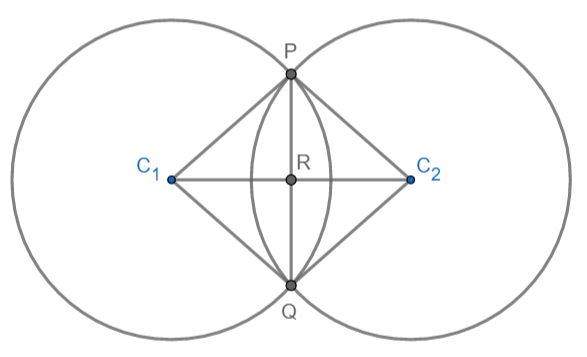Question
Question: If two circles intersect at two points, prove that their center lies on the perpendicular bisector o...
If two circles intersect at two points, prove that their center lies on the perpendicular bisector of the common chord.
Solution
For solving this question, we will first draw the diagram having two circles with center C1 and C2. Common chord will be PQ which cuts the line C1C2 at R. Thus we will have to prove PR = RQ and ∠PRC1=∠PRC2=∠QRC1=∠QRC2=90∘. For this, we will use properties as following:
(I) SSS congruence rule and CPCT (corresponding parts of congruent triangles)
(II) SAS congruence rule and CPCT (corresponding parts of congruent triangles).
(III) Linear pair: If the sum of angles is 180∘ then they form a linear pair.
(IV) Vertically opposite angles are always equal.
Complete step by step answer:
Let us first draw a diagram as per the question requires.
Let the two circles meet each other at two common points P and Q. Let the center of these circles be C1 and C2.

We need to prove that, center lies on the perpendicular bisector of the common chord. According to the diagram, we need to prove that PQ bisects C1 and C2. Let C1 and C2 cut PQ at R. So we need to prove PR = RQ and ∠PRC1=∠PRC2=∠QRC1=∠QRC2=90∘.
We have joined C1P,C1Q,C2P,C2Q to prove our required result.
In ΔPC1C2 and ΔQC1C2.
We know that, PC1=QC1 because both are the radius of the same circle.
Similarly, PC2=QC2 because both are the radius of the same circle.
Also C1C2 is the common base of both triangles.
Therefore, in both triangles all corresponding sides are equal.
So by SSS congruence rule, ΔPC1C2≅ΔQC1C2.
By CPCT (corresponding parts of congruent triangles) we can say that ∠PC1C2=∠QC1C2⋯⋯⋯(1).
Now in ΔPC1R and ΔQC1R.
We know that PC1=QC1 because both are the radius of the same circle.
∠PC1R=∠QC1R using (1). Also, C1R is the common base of both triangles.
Therefore, by SAS congruence rule, ΔPC1R≅ΔQC1R. So by CPCT (corresponding parts of congruent triangles), we can say that PR = RQ.
Therefore, PQ bisects OX.
Now we need to show if it bisects perpendicularly. From ΔPC1R and ΔQC1R we can also say that ΔPRC1=ΔQRC1⋯⋯(2) by CPCT.
As we can see PQ is a line so angles ∠PRC1 and ∠QRC1 will form a linear pair (sum of 180∘)
So we can say that ∠PRC1+∠QRC1=180∘.
From (2) we can say that ∠PRC1+∠PRC1=180∘⇒2∠PRC1=180∘.
Dividing both sides by 2 we get ∠PRC1=2180∘=90∘.
Hence, ∠PRC1=90∘ from (2) we can also say that ∠QRC1=90∘ so we have prove ∠PRC1=∠QRC1=90∘.
Now if PQ and C1C2 cut each other at R then we have two pairs of vertically opposite angles. We know that vertically opposite angles, so we can say ∠PRC1=∠QRC2 and ∠QRC1=∠PRC2.
Therefore, ∠QRC2=90∘ and ∠PRC2=90∘.
Hence ∠PRC1=∠PRC2=∠QRC1=∠QRC2=90∘.
Therefore C1C2 is perpendicular to PQ.
Hence C1C2 is a perpendicular bisector of PQ.
Hence proved.
Note: Students should keep in mind all the properties used for solving this sum. They should try to prove all four angles as 90∘. Make sure to use accurate congruence conditions for two triangles. We have used ∠PC1C2 as ∠PC1R because C1X is just extended line of C1R. So the angle is the same.
